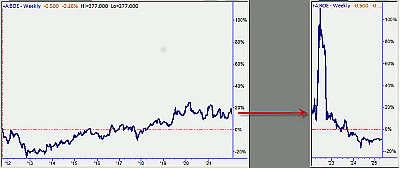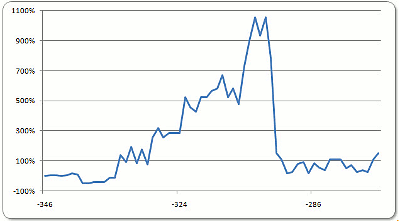As Adam Grimes proves, the speculative bubbles that did so much damage in recent years are neither new nor particularly damaging, once put in a proper historical context.
The past decade has seen some dramatic bubbles and crashes in asset prices. There seems to be a general consensus that if people were in charge, rather than machines, we would not have had these ridiculous price swings. But how quickly we forget!
History is littered with crazy price spikes and asset bubbles-everyone remembers the crude oil mania a few years ago, the dot.com bubble before that, and the Asian crisis in the late 1990s-but this is just the tip of the proverbial iceberg. This process of bidding assets up in mania and then letting them collapse has been going on for all of recorded history, and probably long before that.
Consider the case of company ABC, which is a vaunted blue-chip company-certainly the kind of stock any investment advisor would recommend for a retirement portfolio. The chart above is a weekly percent change chart (indexed to 0% at the beginning of the chart) covering about ten years of price history. This is a textbook picture of a stable stock in a good uptrend, not too exciting but you don't trade a stock like this if you want excitement.
Of course, as you may have guessed, there is a surprise. Fast forward two years, and you see that the stock price spiked dramatically in the course of a few months, and then just as quickly dropped to its previous levels. Do you think fortunes were made and lost in that year? You bet.
Company XYZ is even more dramatic. In fairness, no one ever thought this was a stable company-from the beginning it was always a little more speculative. The chart above shows the price history of this company starting with its IPO in '12.
You can see this was always a bit of a high flyer, but buy and hold investors were rewarded with an 85% appreciation in about eight years, which wasn't bad considering the economic conditions of the time. Still, no one could have foreseen the fervor that drove this stock up more than 1,200% in the next year...nor did most people expect the collapse that followed. Do you see any parallels here to the dot.com bubble?
|pagebreak|These asset bubbles are not limited to equities. Consider the case of the yearly chart of "Mystery Commodity A." This was a staple food item in daily life, and was one of the most widely traded and followed commodities of the time.
For hundreds of years before this chart begins, the price of this item barely changed, then a speculative bubble drove prices up over 1000% in the space of a single generation...and of course you can figure out the rest of the story. There probably were analysts and commentators justifying these both of these price swings, but once again fortunes and empires were made and then lost.
As you have probably figured out, I haven't quite told the whole story here with our "mystery markets." You may have assumed that the '12 was 1912, but these price histories actually begin 200 years earlier: '12 is 1712, and Stock ABC is now the central bank of the UK, the Bank of England.
Company XYZ is the price history of the South Sea Company from 1712 through the South Sea Bubble in 1720. And Mystery Commodity A? Well, if you looked carefully you might have assumed something was wrong with the time axis on that chart, but you would have been wrong! This chart shows the price of dates traded in ancient Babylon from 346 BCE to 275 BCE.
The need to record price histories was probably one of the main motivations for the invention of writing in Sumeria, and this date bubble is one of the first asset bubbles in recorded history. Still, a lot of clay tablets have been lost in the dust of history...
So it is true that the marketplace is experiencing unprecedented structural changes, and the speed of trading is increasing at an ever-faster pace. But in reality, very little has changed. As traders, we tend to have short memories, particularly technical traders who are focused on their favorite pattern or pet indicator.
Most of us would probably do well to consider some longer histories, because patterns do repeat. Next time you hear a politician blame the latest financial innovation for some price spike, maybe you will remember those date traders in ancient Babylon, and think of the words of the prophet: "What has been will be again, what has been done will be done again; there is nothing new under the sun."
Adam Grimes is a trader at SMB Capital and is Director of Tactical Investments at Waverly Advisors.





















